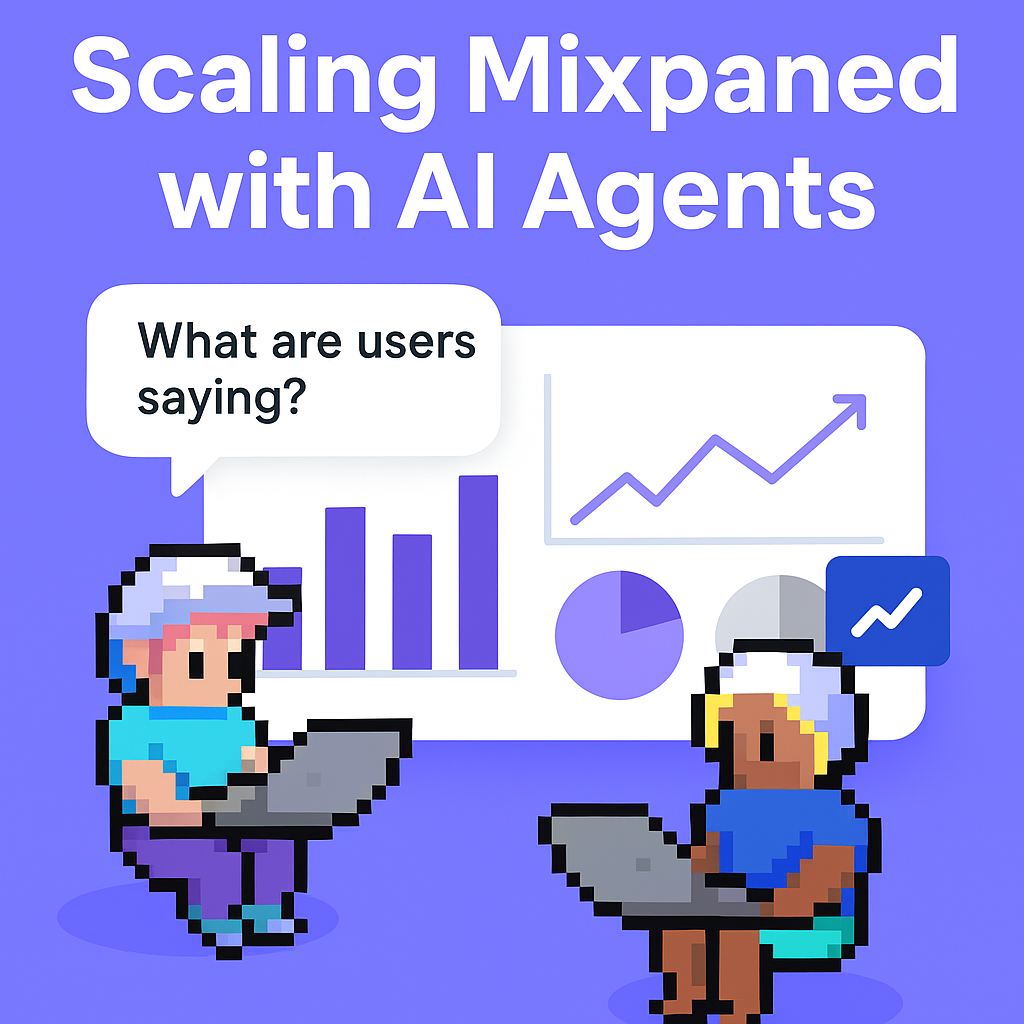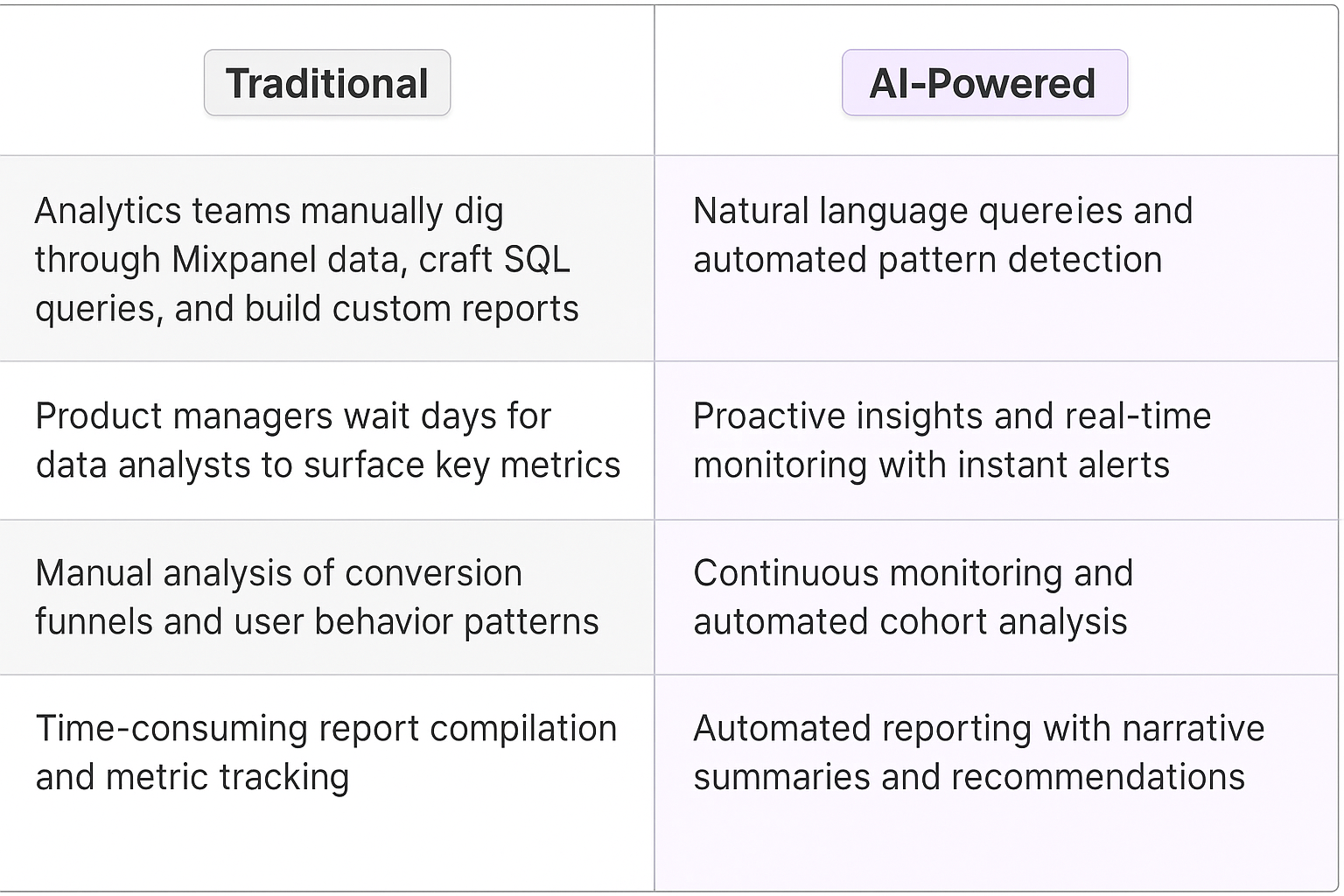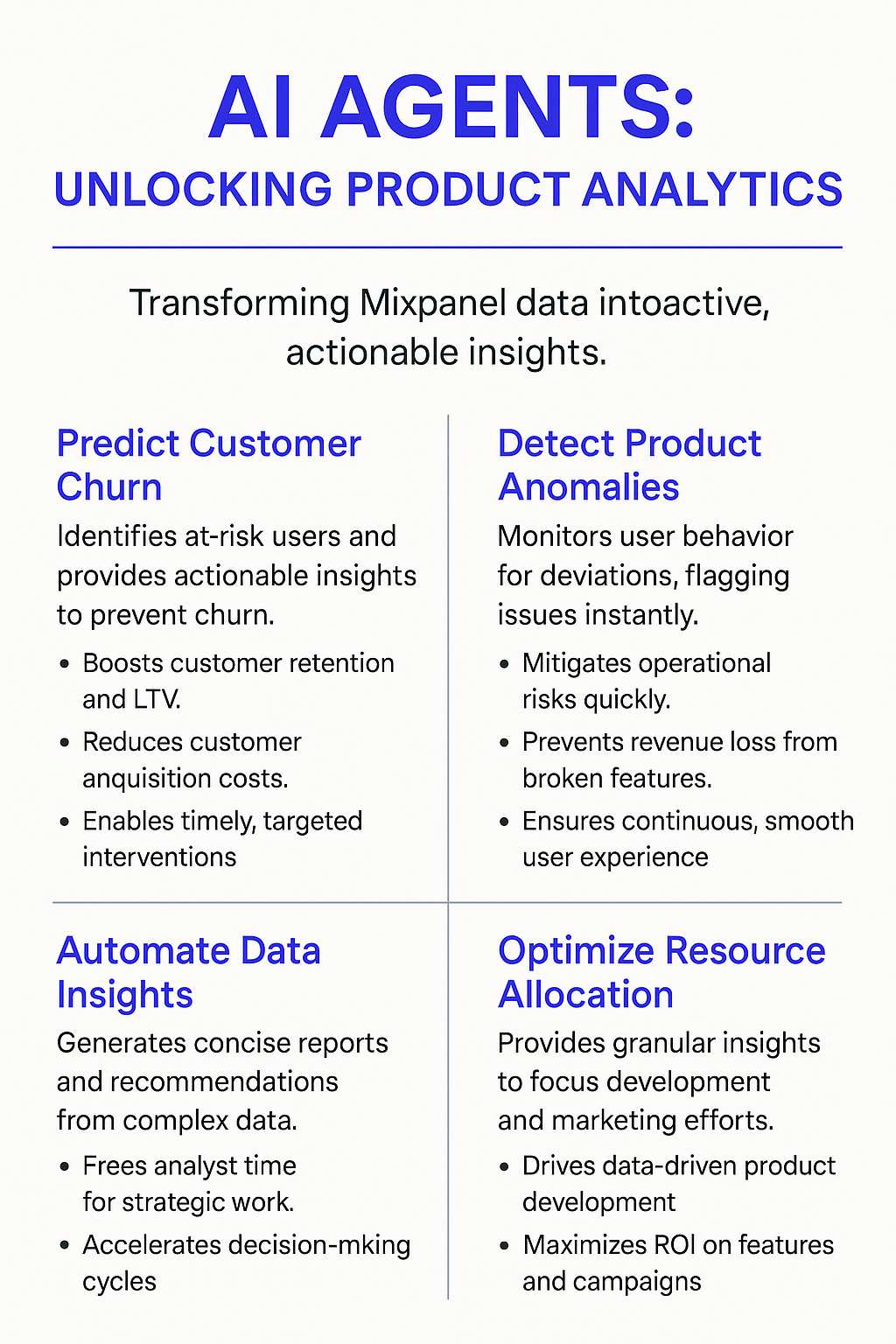Mixpanel
Understanding Mixpanel's Analytics Platform
Mixpanel stands as a powerful product analytics platform that helps teams understand user behavior through event tracking and analysis. The platform excels at providing granular insights into how people interact with digital products, offering sophisticated cohort analysis, funnel visualization, and retention metrics. Unlike traditional analytics tools, Mixpanel focuses on individual user journeys and behavioral patterns that drive product success.
The platform's core strengths lie in its ability to track and analyze user interactions in real-time. Teams can build custom event tracking, create detailed user profiles, and segment audiences based on behavior patterns. Mixpanel's advanced features include:
- Custom event tracking and properties
- Behavioral analytics and cohort analysis
- Funnel analysis and conversion tracking
- User flow visualization
- A/B testing capabilities
- Retention analysis
- Custom dashboards and reports

Benefits of AI Agents for Mixpanel
What would have been used before AI Agents?
Analytics teams traditionally spent countless hours manually digging through Mixpanel data, crafting SQL queries, and building custom reports. They'd have to context switch between documentation, dashboards, and spreadsheets while trying to extract meaningful insights. Product managers and marketers would wait days for data analysts to surface key metrics and user behavior patterns.
What are the benefits of AI Agents?
AI Agents transform how teams interact with Mixpanel's rich analytics data. Instead of wrestling with complex queries, teams can have natural conversations about their metrics. The AI understands context and can pull together multiple data points to answer nuanced questions about user behavior, retention, and conversion.
The network effects are particularly powerful here - as more teams use AI Agents with Mixpanel, the system gets better at understanding industry-specific metrics and KPIs. A gaming company can ask about D1 retention while a SaaS business can probe activation metrics, and the AI knows exactly what to surface.
The real unlock comes from the AI's ability to proactively identify patterns and anomalies. Rather than waiting for someone to notice a drop in conversion rates, the AI can flag concerning trends and suggest potential causes based on correlated events and user segments.
For product teams, this means spending less time manually analyzing data and more time acting on insights. The AI becomes a force multiplier - it can simultaneously monitor hundreds of metrics, segment users in sophisticated ways, and surface actionable insights that would take teams of analysts to discover.
The cold start problem that typically plagues analytics implementations is also largely solved. New team members can start extracting value from Mixpanel data on day one, without needing extensive training on the platform's query language and interface.
Potential Use Cases of AI Agents with Mixpanel
Analytics Deep Dives
Digital teammates can continuously monitor Mixpanel dashboards and surface critical insights about user behavior patterns that might otherwise go unnoticed. They analyze conversion funnels, identify drop-off points, and proactively alert teams when metrics deviate from expected ranges.
Cohort Analysis & Segmentation
AI Agents excel at identifying valuable user segments by analyzing behavioral data across multiple dimensions. They can automatically generate cohort recommendations based on engagement patterns, retention rates, and revenue metrics - giving product teams actionable insights for feature development and marketing campaigns.
Automated Reporting
Rather than manually compiling weekly or monthly analytics reports, AI Agents can generate comprehensive summaries of key metrics, complete with trend analysis and recommendations. They transform raw data into narrative reports that highlight the most relevant insights for different stakeholders.
Real-Time Monitoring
Digital teammates act as always-on monitoring systems, tracking critical metrics and alerting teams when anomalies occur. They can detect unusual spikes in user drop-off, changes in conversion rates, or shifts in feature adoption - enabling rapid response to emerging issues.
Custom Query Generation
AI Agents can translate natural language questions about user behavior into proper Mixpanel queries, making analytics accessible to team members who aren't familiar with the query syntax. This democratizes data access across organizations while maintaining accuracy.
Cross-Platform Analysis
Digital teammates excel at correlating data across multiple platforms and sources. They can combine Mixpanel insights with data from other tools to provide a comprehensive view of user journeys and product performance across web, mobile, and other channels.
Predictive Analytics
AI Agents can analyze historical Mixpanel data to forecast future trends in user behavior, retention, and conversion rates. These predictions help teams proactively adjust strategies and allocate resources more effectively.
A/B Test Analysis
Digital teammates can continuously monitor A/B test results, providing statistical significance calculations and detailed impact analysis. They surface winning variants faster and identify specific user segments where different versions perform better.
By integrating AI Agents with Mixpanel, product teams gain a powerful ally in transforming complex analytics data into actionable insights. These digital teammates work tirelessly to surface patterns, anomalies, and opportunities that drive product success.

Industry Use Cases
The integration of AI agents with Mixpanel analytics creates powerful new capabilities for businesses to extract meaningful insights from their data. Companies across different sectors leverage these digital teammates to transform raw analytics into actionable intelligence. From e-commerce platforms tracking customer journeys to SaaS companies monitoring user engagement, AI agents serve as expert analysts working alongside human teams.
What makes AI agents particularly effective in Mixpanel environments is their ability to process vast amounts of behavioral data and surface patterns that might otherwise go unnoticed. They excel at identifying correlations between user actions, feature adoption rates, and business outcomes - the kind of deep analysis that traditionally required dedicated data science teams.
The real value emerges when AI agents move beyond basic reporting to provide strategic recommendations based on Mixpanel's rich dataset. They can detect early warning signs of customer churn, highlight opportunities for feature optimization, and identify the most impactful areas for product improvements. This combination of analytical horsepower and strategic insight makes AI agents invaluable partners for teams looking to make data-driven decisions.
Gaming Industry: Leveling Up Player Analytics with Mixpanel AI
Mobile gaming studios face intense pressure to understand and act on player behavior data in real-time. Traditional analytics workflows require data analysts to spend hours building cohorts, analyzing retention curves, and investigating churn patterns. Mixpanel AI agents transform this process by continuously monitoring player data streams and surfacing actionable insights automatically.
A mid-sized mobile gaming studio implemented Mixpanel AI to analyze player progression through their match-3 puzzle game. The AI agent detected that players who failed level 8 more than three times had a 67% chance of churning within 48 hours. This granular insight allowed the studio to dynamically adjust the difficulty curve and introduce targeted power-up rewards specifically for these at-risk players.
Beyond reactive analytics, the AI agent proactively identified opportunities to increase player engagement. It discovered that players who joined guilds within their first week showed 3x higher retention rates and 2.4x higher in-app purchase rates. The studio used this data to redesign their new player onboarding flow, prominently featuring guild discovery and social features.
The most powerful aspect of Mixpanel AI in gaming is its ability to synthesize insights across multiple data dimensions. For example, correlating player spending patterns with social interactions, game progression, and session timing. This multi-dimensional analysis revealed that players who received in-game gifts from friends during evening sessions were 40% more likely to make their first purchase within 24 hours.
Gaming studios using Mixpanel AI have reported 23% improvements in day-30 retention and 31% increases in average revenue per daily active user (ARPDAU). The key is shifting from reactive analytics to proactive optimization powered by continuous AI monitoring of player behavior patterns.
E-commerce: Converting Behavioral Data into Revenue with Mixpanel AI
Online retailers operate in a world where milliseconds and micro-interactions determine whether a shopper converts or bounces. Mixpanel AI agents analyze these subtle behavioral patterns at scale, detecting friction points and revenue opportunities that human analysts might miss.
A direct-to-consumer fashion brand deployed Mixpanel AI to decode their mobile app's purchase funnel. The AI agent identified that users who viewed size charts spent 40% more time in product detail pages but had 25% lower conversion rates. Digging deeper, it revealed that mobile users accessing size charts between 9 PM and midnight showed particularly high drop-off rates - suggesting decision paralysis during prime shopping hours.
The brand responded by implementing AI-driven size recommendations based on previous purchase history and return data. They also redesigned the mobile size chart interface for late-night browsing sessions. The result? A 34% increase in conversion rates during evening hours and a 22% reduction in size-related returns.
Mixpanel AI's real power shines in connecting seemingly unrelated behavioral signals. The agent discovered that shoppers who engaged with user-generated content (UGC) in the first 3 minutes of their session had 2.8x higher average order values. This insight led to a complete restructuring of the product discovery experience, prominently featuring authentic customer photos and reviews above the fold.
The most valuable pattern emerged from cart abandonment analysis. The AI agent found that shoppers who received personalized browse abandonment emails within 4 hours were 3.5x more likely to complete their purchase if the email included similar items from their browsing history rather than the exact items they abandoned. This counter-intuitive finding challenged conventional retargeting wisdom and drove a 47% increase in email-driven revenue.
E-commerce brands using Mixpanel AI have seen 28% improvements in conversion rates and 41% increases in customer lifetime value. The key lies in moving beyond basic analytics to leverage AI-driven behavioral intelligence that adapts to changing customer preferences in real-time.

Considerations & Challenges
Implementing Mixpanel AI agents requires careful planning and awareness of several key factors that can impact success. The complexity goes beyond simple integration - it touches data governance, user privacy, and analytical accuracy.
Technical Challenges
Data quality forms the foundation of effective Mixpanel AI agent implementation. Poor or inconsistent tracking can lead to skewed insights and unreliable recommendations. Teams need robust event taxonomies and clear naming conventions before deployment.
API rate limits pose another technical hurdle. High-volume analytics operations can quickly hit thresholds, requiring thoughtful request batching and queueing mechanisms. Teams should implement retry logic and failure handling to maintain data integrity.
Integration with existing analytics stacks demands careful architecture planning. Duplicate events, conflicting properties, and mismatched user identifiers can create analytical blind spots. A comprehensive data mapping strategy helps prevent these issues.
Operational Challenges
User adoption often becomes a significant barrier. Analytics teams may resist changing established workflows, especially if they've built complex custom reports. Creating clear documentation and providing hands-on training sessions helps smooth the transition.
Cost management requires ongoing attention. AI agent queries can drive up usage costs, particularly with large historical data sets. Teams should implement usage monitoring and set up alerts for unusual spikes in API calls.
Maintaining data accuracy becomes more complex with AI agents in the loop. Regular validation of AI-generated insights against manual analysis helps catch potential discrepancies early. Teams should establish clear processes for reviewing and correcting AI interpretations when needed.
Privacy compliance adds another layer of complexity. AI agents need proper configuration to handle sensitive data appropriately. Teams must ensure GDPR, CCPA, and other relevant privacy requirements are met through careful data filtering and access controls.
AI-Powered Evolution in Product Analytics
The integration of AI Agents with Mixpanel represents a significant evolution in product analytics. By combining Mixpanel's robust data capabilities with AI-powered analysis, teams gain unprecedented ability to extract actionable insights from their user data. The success stories from gaming studios and e-commerce platforms demonstrate the tangible impact of this technology fusion. While challenges exist around implementation and data governance, the benefits of enhanced analytical capabilities and proactive insights make AI Agents an invaluable addition to the modern product analytics stack.











